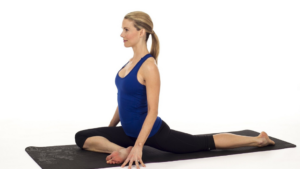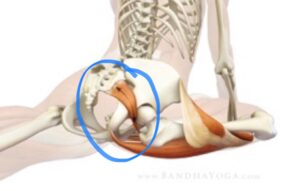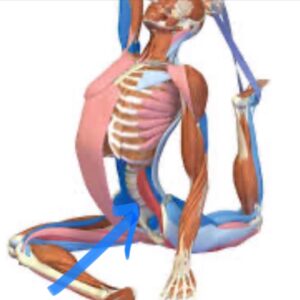Pigeon Pose

I will load each week’s content below in the tabs. The most current week will show first in blue, but you’ll be able to click the boxes in grey beside the blue tab to view previous content.
Happy Wednesday!
The few shorter classes I’ve made have been extremely popular, so I’ve made another one! This week’s 38-minute Power Flow tones and stretches your whole body with core work, a variety of standing postures, as well as deep-opening poses. Click here to go to my website for this new class. Enjoy!!
If you would like any of my classes without the music, I am always happy to send them to you. Simply email me back, and I will send you a separate link!
Did you see last week’s cue on how to use Pigeon Pose not only to stretch the piriformis, but also the psoas, hip flexors, and abs?
Begin in Pigeon pose with the right leg forward and your torso upright. Place the pads of your fingertips on the ground and anchor through your back foot. Drag/roll your LEFT hip towards your RIGHT (front) heel and look over your right shoulder.
Why?
By dragging your left hip towards your right heel, you help even out the hips. If you are looking to stretch the external rotators on the right side and your hips tilt in that same direction, you will not get the full benefit of the stretch. Let’s look at some pictures below from Ray Long’s Daily Bandha to understand the anatomy behind this.

Since so many of us approach Pigeon pose with the intention of stretching the piriformis, take a look at the picture above. Note where the piriformis is and where it attaches – one point of attachment is on the sacrum and the other is on the top of the femur (I’m intentionally keeping the terminology simple). If your pelvis is tilted to the side of the right bent leg, and you use the cue to drag/roll the left hip toward the right heel, you can see how the sacrum will move away from the head of the femur and intensify the stretch.
Now, is it dangerous to have the hips tilted? In my opinion, no. Some people may still feel a nice stretch with a tilt in the hips. And, it may be necessary for some until they “open up” a little more to ensure comfort around the knee.

When you look over your right shoulder in an upright position, you’ll notice the left side of your rib cage will draw forward. This will not only help you square the hips, but you will also feel a deeper stretch in the left psoas, hip flexors, and abdominals. Take a look at the picture above with the arrow pointing to the psoas (red muscle). Because the psoas attaches onto the lumbar spine (amongst other areas) and the head of the femur, when you look over your right shoulder, you naturally twist through the spine and pull the lumbar spine to the right. This action increases the stretch in the psoas, hip flexors, and the abdominals on the left.
Make sure to try this cue with the left leg forward to maximize the stretch on your left piriformis and right psoas.
If traditional Pigeon bothers your knees or hips, you can check out the animation I shared last week on how you can best stretch your piriformis muscle in supine pigeon. Click here or on the image below for the YouTube video.
One inspiring tip:
From your upright Pigeon pose, turn your back toes under, lift your knee, and hold for a few breaths. Feel the stretch in the front of the back hip/hip flexors. Then, let your knee come back to the ground and repeat 3-4 times. You will feel more sensation (if that’s what you need) in your hips flexors because you are moving your femur bone, where the psoas attaches, when you lift your knee off the ground.
One inspiring song:
I’m slightly obsessed with this upbeat song…you will hear it in one of my videos this month. Emmit is an artist that my nephew in California manages and because of this, his songs are legal for me to use in my videos!
One inspiring quote:
“Happiness is the new rich. Inner peace is the new success. Health is the new wealth. Kindness is the new cool.”
Happy Wednesday!
I am currently in Galena and having some technical difficulties uploading this week’s video. I promise to send you the link for the class by Thursday or Friday. In the meantime, here’s a preview of what you can expect, along with a fun find for this month’s theme – Pigeon.
This week’s class is a 70-minute flow set to tunes from DJ Taz, Emmitt Finn, Nombe, and other great artists. It’s a solid flow with bouts of getting the heart rate up and the breath flowing. You will move through many of your favorite standing poses with extra planks, mountain climbers, and core work. And, of course, Pigeon Pose at the end.
As I’ve mentioned before, I started adding in the music AFTER I record the class, which makes the quality of the sound better for you! Once you take the class, I’d appreciate any feedback you’d like to give so I can share it with other students before they take it. This goes for any of the classes you have taken that are currently posted to my website. Thank you in advance for this!
When you get to Pigeon pose at the end of the class, feel free to try last week’s cue for engagement of the front outer thigh to protect the knee. For even more tips and alignment cues for Pigeon, check out my Instagram posts this month. I’ll be sharing variations of the pose as well as opinions on the “right” alignment from other long-time instructors.
For now, feel free to click here for a short animation of supine Pigeon. It’s a visual of how the piriformis muscle is stretched, and you’ll notice that when your hips are on the ground vs. lifted up slightly, the piriformis muscle is stretched more. Both ways are good, but you will see how a slight shift in alignment can target different muscles in different ways. C’mon…you know that’s pretty cool!! =)
Stay hydrated with all of this crazy heat!!
One inspiring cue:
Pigeon pose seems to be a pose that students want to practice in nearly every class. It’s also a pose that instructors like to debate about relative to “proper” alignment, form, and safety on Instragram and Facebook. And, as you can imagine, body experts sometimes disagree as well. This is why I feel it’s always important for you to remain educated (why I send you quick and easy articles to read/videos to watch) so you can decide for yourself what you feel is healthiest for you. Dr. Ray Long, whose opinions I respect very much, suggests the following cue to keep the knees a little safer in Pigeon:
Once in traditional Pigeon pose, press the pinky edge of your FRONT foot into the mat (scroll down to this week’s tip for the link to a video I made to demonstrate this).
Why?
When you press the pinky edge of your front foot down, you will notice your ankle rolls out/externally rotates a bit. Dr. Ray Long says, “slightly externally rotating the ankle activates the hamstring on the lateral side (outside) of the thigh. These actions create a type of dynamic ‘brace’ on the outside of the leg, protecting the inside of the knee.”
Click here or on the image below to go to my website for this week’s Favorite Find. It’s an anatomy-focused article by Ray Long on how to keep the knees protected in your Pigeon variation.
One inspiring tip:
Try an active pigeon with your right foot forward. Begin by floating your right hip a few inches off of the ground and pressing your whole right leg as well as the pinky-side edge of your right foot down into your mat. Remain upright in your spine for this active version.
When practicing Pigeon this way, you strengthen your external rotators while they are in a lengthened position. When you work muscles in this way, at the end of their range of motion, it is believed the overall health and strength of the muscle will improve.
One inspiring song:
“Southern Sun” by Boy and Bear
One inspiring quote:
“Happiness is the highest form of health.”
– Dalai Lama
